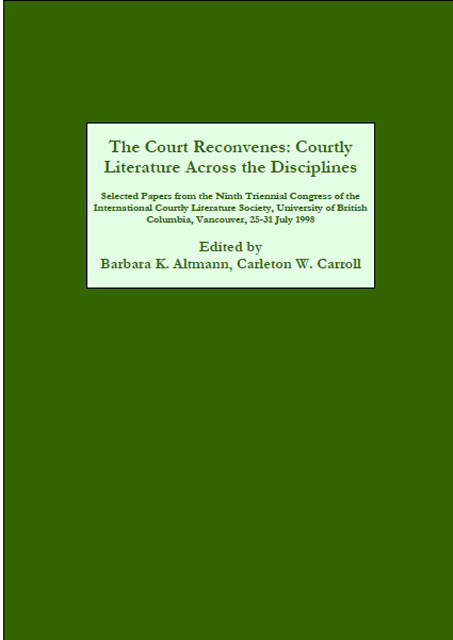 The Court Reconvenes
The Court Reconvenes Bisclavret to Biclarel via Melion and Bisclaret: The Development of a Misogynous Lai
Published online by Cambridge University Press: 31 March 2023
Summary
There are four medieval werewolf lais. The Bisclavret of Marie de France reappears in an Old Norse translation as Bisclaret and again under the title Biclarel in the earlier redaction of the Old French Roman de Renart le Contrefait. Finally there is the anonymous lai Melion, which contains material analogous to Marie's narrative, notably the hero's entrapment in lupine form, the acceptance of the werewolf by the king, and the recovery of Melion's human form. The structural divergences between the two lais led Kittredge to suggest that Bisclavret and Melion were “independent redactions of the same saga” (173). Although Melion and Biclarel are similar to Bisclavret in the basic premises of the metamorphosis and betrayal plot, both structural alterations and narrative voice indicate differences in authorial intention; Melion, whose composition Tobin ascribes to a jongleur (1976 292), gradually reveals a misogynous bias, and Renart explicitly recounts Biclarel as an exemplum in an episode devoted to the condemnation of marriage and the folly of men who marry. For reasons of space, the present paper will focus on the presentation of the wife and the betrayal.
In Bisclavret the lady's extraction of her husband's secret is presented primarily as dialogue: Bisclavret's wife taxes him about his absences, professing to believe that he has taken a lover. In the face of his denials, the lady decries his secrecy, presenting it as a lack of faith on her husband's part. She cajoles him with tears and protestations of her love and trustworthiness. Bisclavret admits his werewolfism, but when the lady discovers the truth she demands further, more specific, details: does he remove his clothes before changing his shape? Where does he put them? She thereby discovers the information she requires to be rid of her husband.
Marie recounts the orchestration of the theft of the clothes, and the lady's subsequent remarriage, without additional comment. The denouement is marked by the same neutrality. When he recovers his human shape, the hero remains as silent as when he had no access to speech; both Bisclavret and Marie look on as the king pronounces sentence on the lady. Marie mixes subtle suggestions of justification (the wife's fear at Bisclavret's revelation, 97–9), and condemnation (the references to her treatment of her husband in terms of betrayal, 125–26, and to the wolf-hero's attack upon his wife in terms of revenge, 234).
- Type
- Chapter
- Information
- The Court ReconvenesCourtly Literature across the Disciplines: Selected Papers from the Ninth Triennial Congress of the International Courtly Literature Society, University of British Columbia, Vancouver, 25-31 July 1998, pp. 317 - 324Publisher: Boydell & BrewerPrint publication year: 2002


